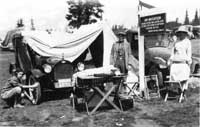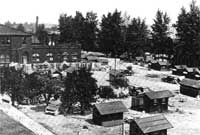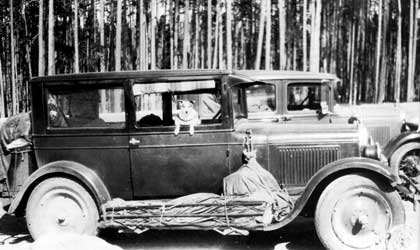Grants Pass and Ashland preceded larger cities in the region by opening municipal auto camps in 1915. Grants Pass was first to open its auto camp. The city made use of Riverside Park, an area opened in 1910, to provide public access to the Rogue River. A park fund was initiated in 1914 so that an automobile entrance and an adjoining campground could be constructed. The latter was built in 1915:
… on the river bank east of the park and all camp conveniences were provided to make the stop of this class of tourists in Grants Pass as pleasant as possible. The town, already a popular stopping place for train passengers and auto tourists who stayed in hotels, needed the campgrounds to provide for those who carried camping equipment and did not stay in the hotels. [5]
|
Tents were rolled up and placed below the door to keep more room inside the cars for camping equipment, clothes, people and pets. July 1930; Courtesy Southern Oregon Historical Society |
Ashland began construction of Lithia Park in 1909, situating it adjacent to Chautauqua Park. The local boosters lost no time in trying to capitalize upon auto tourists traveling to the Panama Pacific Exposition held in San Francisco during 1915. They opened a ninety-two acre auto camp on July 22, 1915. [6] Originally, there was no charge nor limit to the length of stay.
By 1916 Ashland had expended $l75,000 on Lithia Park, much of which went to developing the auto camp. Tourists were attracted by amenities like mineral water, a community house with gas stoves for cooking, a nearby grocery store, electric lights with individual switches (so that campers could sleep in the dark), and even a laundry wagon that picked up wash each morning and returned it the next day. [7]
Although the argument for free municipal campgrounds was that they simply filled out the range of accommodation available in a community, it was not long before the urge to compete with other towns led to expensive improvements. As the number of automobiles grew rapidly in the years following World War I there was increasing pressure to levy a charge for use of the facilities in municipal campgrounds.
Disgruntled hotel keepers and entrepreneurs who wanted to open private camps viewed the free municipal camps as unfair competition and pressed the park boards to eliminate them.
Both Grants Pass and Ashland instituted a charge of fifty cents per night in their municipal camps beginning in 1923. That year 15.2 million cars were registered in the United States, whereas in 1912 there had been only one million registered vehicles. The number of cars increased to nineteen million in 1924, a year when it was estimated that five million vehicles and fifteen million Americans would occupy campgrounds across the U.S. [8] Mr. and Mrs. C. E. Lane and Hazel Emery relax with their auto tent at Mt. Rainier. ca 1923; Courtesy Southern Oregon Historical Society #15983
Mr. and Mrs. C. E. Lane and Hazel Emery relax with their auto tent at Mt. Rainier. ca 1923; Courtesy Southern Oregon Historical Society #15983
 Although the private camps had started renting tent space, their proprietors soon realized that cabins with a few amenities attracted customers. Merrick’s Auto Camp in Medford. ca 1930; Courtesy Southern Oregon Historical Society #8940
Although the private camps had started renting tent space, their proprietors soon realized that cabins with a few amenities attracted customers. Merrick’s Auto Camp in Medford. ca 1930; Courtesy Southern Oregon Historical Society #8940
Although tent sales peaked between 1923 and 1924, many auto campers wanted to bring less camping equipment with them. Private camps attracted their share of the auto camping public because municipal camps were often crowded in the summer and had established limits on how long a tourist could stay. Although the private camps had started by renting tent space, their proprietors soon realized that cabins with a few amenities attracted customers. Cabins appeared in the Grants Pass and Ashland municipal camps by 1925, but by this time these operations had to compete with a number of private camps which sprouted along the newly numbered and paved highways.


